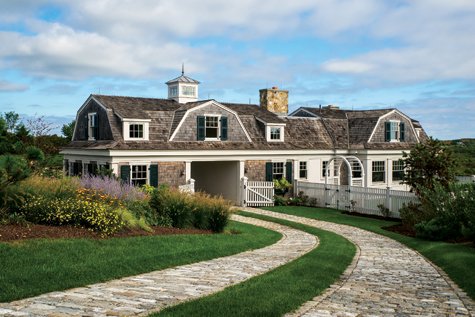HOME PORTRAIT

Storied Homes
The Architecture of Patrick Ahearn
By John Budris Photography by Greg Premru
We make sense of our lives by the stories we tell ourselves about those lives. And no place is the curator of those stories like a home. It needn’t be an ancestral house or the place where we raise our families. It might be the cottage we visit only in summer. Or a chalet in the mountains. Or a city condo-minium. Or even the dream home still in the dream stage.
Talk to Patrick Ahearn long enough about architecture, and that’s what you take away: Houses are the frames around our lives. We build them to shelter the spiritual as much as the physical. “I’ve been designing houses for close to a half-century now, and two very simple - obvious even - principles never change. A good house design will make the people who live in it happier. And the past provides the best lessons for today’s and tomorrow’s design,” Patrick told me on a raining summer afternoon in his Edgartown office. In so many words, he’s told it to me many times, in many ways.
I’veknown Patrick since he landed on the Vineyard. I’ve talked to him about what he does and how he builds for a couple decades, both on the Vineyard and in Boston. Perhaps the greatest measure of his personal influence is that he’s in my head whenever I have a decision to make about the ongoing restoration and expansion of my own 1840s farmstead. “What would Patrick do?” I often ask myself when faced with some crucial decision. Should I bump out a new pantry on the north side of the house? Could I re-purpose the old cow feeding stalls in the barn into a workshop? Will a planned bedroom dormer to capture the sunrise overly disrupt the elegant roofline? And then, as if the judge walked into my mental courtroom: Would Patrick approve?
Patrick has been so prolific as an urban designer and architect in the last 45 years it’s impossible to categorize him. On Martha’s Vineyard, some 200 projects are in his rearview mirror - from grand, shingle-style homes reminiscent of Newport mansions to modest 800 square-foot cottages - and everything else in between, including commercial and public projects. Some 20 more are in development. In Boston, he’s worked on more than 1000 projects with some 400 in historic Back Bay. Take a stroll down a Newbury Street block or an Edgartown neighborhood, and Patrick Ahearn’s invisible touch is everywhere. He explains that perhaps an architect’s greatest achievement is making a neighborhood work better and no one notices, “where the architect comes in as the ghost in the night.”
He didn’t come to architecture right out of the gate. Cars were his first passion. “That’s my father’s fault,” Patrick says, grinning. Even as a toddler, he spent hours washing and shining his father’s 1953 Ford Victoria, internalizing the curves and textures of the bumpers, body, and interior, feeling his way to understanding the principles of good design. That might be the germ that led to his collection of classic cars, which he enshrines in what at first glance appears to be a grand New England barn at the Field Club in Katama. After high school, he considered pursuing automotive design but instead studied urban design at Syracuse University, graduating with both Bachelors and Masters degrees in Architecture. Moving to Boston, his early career included stints with Benjamin Thompson & Associates and The Architects Collaborative, where he was part of a team that saved the Faneuil Hall district from the wrecking ball. During that period, he worked on waterfront projects in Miami and Baltimore and multiple enterprises in the Middle East, including a new Petrochemical City in Jubail, Saudi Arabia.
But the architect’s alpha gene was too strong, and in 1978, Patrick opened his own firm - Ahearn Schopfer & Associates - with an eye on a moribund Back Bay. About a decade later, he fell in love with Edgartown.
Although much of his resume is in historical neighborhoods - both on and off the Vineyard - he is not a strict preserva-tionist, per se. He’s not out to recreate Old Sturbridge Village. His charge is not to take a snapshot in time past and freeze it for time to come. His charge is to make sense of the identity and character of the project within the neighborhood. “Because restored residences are meant to be truly lived in by their current occupants and successive generations, they must be brought up to date, no matter how much conservation work we do or how many antiques fill them when we’re done,” Patrick penned in his book Timeless - Classic American Architecture for Contemporary Living. (see page 36)
Since he began his career as an urban designer, where the finished work must dovetail with the existing neighborhood and at very close quarters, he learned a most valuable fundamental early in the game. “And the lesson here is when the neighbors are happy, the client is happy too,” Patrick says. As important, he explains, the inverse is also true.
Patrick grew up in one such suburban New York neighborhood. Levittown may have been the satirical target of the song Little Boxes, popularized by the late Pete Seeger, but coming of age in the Long Island community was arguably Patrick’s most profound teacher. Conceived in the late 1940s on dormant potato fields by developer William Levitt and his architect brother, Alfred, Levittown is to the suburb what the Model T Ford is to the car: a pioneer of mass-produced good design that changed society, Patrick explains. “Levittown taught me vital lessons and principles that I’ve carried through my career. It made me appreciate density and scale, and the balance between the two: the community was spread out over just a few square miles, but the homes’ modest size turned their concentration into a virtue,” Patrick notes in Timeless.
In a sense, Levittown merged the best of city and country living in a single space. The Levitt brothers understood that the space between the homes was as integral as the homes themselves. A balance of grass, trees, and its 1001 curving lanes lent a sense of timelessness as if the development had been there for generations even when spanking new. The Levitt’s homes were also designed to seamlessly expand as the family’s needs and resources expanded. This ability to evolve was central to Levittown’s success, as the next generation reimagined and customized the buildings, Patrick explains. “I was taking all of this in without even knowing it as I grew up,” he says.
No house - even a solitary cabin in the wilderness - exists without context. Every house has a story, a script, a role in the neighborhood, so to speak. This “scripting” is the roadmap Patrick follows in all of his designs, whether new construction or renovation and restoration. Houses can have an evolved history, even when that history is imaginary. Patrick and wife Marsha’s Edgartown home is perhaps the most succinct example of this guiding principle.
The house was built brand new, so its “history” Patrick needed to create from whole cloth. The invented narrative of their home has chapters in three different centuries. “In the golden era of whaling, Edgartown’s wealthy captains had grand mansions on the harbor. Our lot wouldn’t have had that, but a lesser mariner might have his house and family here,” Patrick explains. “A generation or two later, maybe, a farmer buys the property and adds a barn to one side of the house, and in another generation, the next owner builds a livery stable.” And then, he explains, in this century, he and Marsha - who did the interior decorating, as she’s done in many of Patrick’s projects - come along and restore and repurpose the “vintage” buildings into contemporary living quarters with all the amenities from a swimming pool, home theatre, and elegant courtyard, all the while retaining the design and detail of what could have been original.
At 67 - and with no sign of downshifting - his resume is replete with awards and recognition in architecture and design. He’s the recipient of multiple Bulfinch, PRISM, and BRICC awards, among many others, in many categories. He was selected by Home and Garden Television to design HGTV’s Dream Home in 2015. The American Institute of Architects inducted Patrick into its College of Fellows in 2015 as did the New England Design Hall of Fame in 2013. He serves as a trustee to his alma mater, Syracuse University.
These honors Patrick takes in quiet stride. But if you really want a smile of pride to emerge from behind his mustache, get him talking about his son, Conor. Schooled at Detroit’s College for Creative Studies, Conor conceptualized a design which allows the disabled - especially those with severe arthritis - to use hand and garden tools pain-free. He has a passion for car design and customization and is rehabilitating some of Detroit’s elegant but neglected homes in neighborhoods in need of revitalization. Sound familiar?
An implied warranty comes with every Patrick Ahearn home: The inhabitants will be in each other’s lives and out of each other’s way for a long, long time.
Talk to Patrick Ahearn long enough about architecture, and that’s what you take away: Houses are the frames around our lives. We build them to shelter the spiritual as much as the physical. “I’ve been designing houses for close to a half-century now, and two very simple - obvious even - principles never change. A good house design will make the people who live in it happier. And the past provides the best lessons for today’s and tomorrow’s design,” Patrick told me on a raining summer afternoon in his Edgartown office. In so many words, he’s told it to me many times, in many ways.
I’veknown Patrick since he landed on the Vineyard. I’ve talked to him about what he does and how he builds for a couple decades, both on the Vineyard and in Boston. Perhaps the greatest measure of his personal influence is that he’s in my head whenever I have a decision to make about the ongoing restoration and expansion of my own 1840s farmstead. “What would Patrick do?” I often ask myself when faced with some crucial decision. Should I bump out a new pantry on the north side of the house? Could I re-purpose the old cow feeding stalls in the barn into a workshop? Will a planned bedroom dormer to capture the sunrise overly disrupt the elegant roofline? And then, as if the judge walked into my mental courtroom: Would Patrick approve?
Patrick has been so prolific as an urban designer and architect in the last 45 years it’s impossible to categorize him. On Martha’s Vineyard, some 200 projects are in his rearview mirror - from grand, shingle-style homes reminiscent of Newport mansions to modest 800 square-foot cottages - and everything else in between, including commercial and public projects. Some 20 more are in development. In Boston, he’s worked on more than 1000 projects with some 400 in historic Back Bay. Take a stroll down a Newbury Street block or an Edgartown neighborhood, and Patrick Ahearn’s invisible touch is everywhere. He explains that perhaps an architect’s greatest achievement is making a neighborhood work better and no one notices, “where the architect comes in as the ghost in the night.”
He didn’t come to architecture right out of the gate. Cars were his first passion. “That’s my father’s fault,” Patrick says, grinning. Even as a toddler, he spent hours washing and shining his father’s 1953 Ford Victoria, internalizing the curves and textures of the bumpers, body, and interior, feeling his way to understanding the principles of good design. That might be the germ that led to his collection of classic cars, which he enshrines in what at first glance appears to be a grand New England barn at the Field Club in Katama. After high school, he considered pursuing automotive design but instead studied urban design at Syracuse University, graduating with both Bachelors and Masters degrees in Architecture. Moving to Boston, his early career included stints with Benjamin Thompson & Associates and The Architects Collaborative, where he was part of a team that saved the Faneuil Hall district from the wrecking ball. During that period, he worked on waterfront projects in Miami and Baltimore and multiple enterprises in the Middle East, including a new Petrochemical City in Jubail, Saudi Arabia.
But the architect’s alpha gene was too strong, and in 1978, Patrick opened his own firm - Ahearn Schopfer & Associates - with an eye on a moribund Back Bay. About a decade later, he fell in love with Edgartown.
Although much of his resume is in historical neighborhoods - both on and off the Vineyard - he is not a strict preserva-tionist, per se. He’s not out to recreate Old Sturbridge Village. His charge is not to take a snapshot in time past and freeze it for time to come. His charge is to make sense of the identity and character of the project within the neighborhood. “Because restored residences are meant to be truly lived in by their current occupants and successive generations, they must be brought up to date, no matter how much conservation work we do or how many antiques fill them when we’re done,” Patrick penned in his book Timeless - Classic American Architecture for Contemporary Living. (see page 36)
Since he began his career as an urban designer, where the finished work must dovetail with the existing neighborhood and at very close quarters, he learned a most valuable fundamental early in the game. “And the lesson here is when the neighbors are happy, the client is happy too,” Patrick says. As important, he explains, the inverse is also true.
Patrick grew up in one such suburban New York neighborhood. Levittown may have been the satirical target of the song Little Boxes, popularized by the late Pete Seeger, but coming of age in the Long Island community was arguably Patrick’s most profound teacher. Conceived in the late 1940s on dormant potato fields by developer William Levitt and his architect brother, Alfred, Levittown is to the suburb what the Model T Ford is to the car: a pioneer of mass-produced good design that changed society, Patrick explains. “Levittown taught me vital lessons and principles that I’ve carried through my career. It made me appreciate density and scale, and the balance between the two: the community was spread out over just a few square miles, but the homes’ modest size turned their concentration into a virtue,” Patrick notes in Timeless.
In a sense, Levittown merged the best of city and country living in a single space. The Levitt brothers understood that the space between the homes was as integral as the homes themselves. A balance of grass, trees, and its 1001 curving lanes lent a sense of timelessness as if the development had been there for generations even when spanking new. The Levitt’s homes were also designed to seamlessly expand as the family’s needs and resources expanded. This ability to evolve was central to Levittown’s success, as the next generation reimagined and customized the buildings, Patrick explains. “I was taking all of this in without even knowing it as I grew up,” he says.
No house - even a solitary cabin in the wilderness - exists without context. Every house has a story, a script, a role in the neighborhood, so to speak. This “scripting” is the roadmap Patrick follows in all of his designs, whether new construction or renovation and restoration. Houses can have an evolved history, even when that history is imaginary. Patrick and wife Marsha’s Edgartown home is perhaps the most succinct example of this guiding principle.
The house was built brand new, so its “history” Patrick needed to create from whole cloth. The invented narrative of their home has chapters in three different centuries. “In the golden era of whaling, Edgartown’s wealthy captains had grand mansions on the harbor. Our lot wouldn’t have had that, but a lesser mariner might have his house and family here,” Patrick explains. “A generation or two later, maybe, a farmer buys the property and adds a barn to one side of the house, and in another generation, the next owner builds a livery stable.” And then, he explains, in this century, he and Marsha - who did the interior decorating, as she’s done in many of Patrick’s projects - come along and restore and repurpose the “vintage” buildings into contemporary living quarters with all the amenities from a swimming pool, home theatre, and elegant courtyard, all the while retaining the design and detail of what could have been original.
At 67 - and with no sign of downshifting - his resume is replete with awards and recognition in architecture and design. He’s the recipient of multiple Bulfinch, PRISM, and BRICC awards, among many others, in many categories. He was selected by Home and Garden Television to design HGTV’s Dream Home in 2015. The American Institute of Architects inducted Patrick into its College of Fellows in 2015 as did the New England Design Hall of Fame in 2013. He serves as a trustee to his alma mater, Syracuse University.
These honors Patrick takes in quiet stride. But if you really want a smile of pride to emerge from behind his mustache, get him talking about his son, Conor. Schooled at Detroit’s College for Creative Studies, Conor conceptualized a design which allows the disabled - especially those with severe arthritis - to use hand and garden tools pain-free. He has a passion for car design and customization and is rehabilitating some of Detroit’s elegant but neglected homes in neighborhoods in need of revitalization. Sound familiar?
An implied warranty comes with every Patrick Ahearn home: The inhabitants will be in each other’s lives and out of each other’s way for a long, long time.








